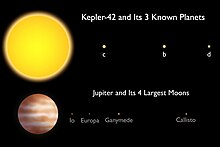Kepler-42
|
Star Kepler-42 |
|||||
|---|---|---|---|---|---|

|
|||||
| Artist's impression of Kepler-42 and its planetary system | |||||
| AladinLite | |||||
|
Observation dates equinox : J2000.0 , epoch : J2000.0 |
|||||
| Constellation | swan | ||||
| Right ascension | 19 h 28 m 52.57 s | ||||
| declination | + 44 ° 37 ′ 9 ″ | ||||
| Apparent brightness | 16.12 mag | ||||
| Typing | |||||
| Known exoplanets | 3 | ||||
| R − I index | (2.26) | ||||
| Spectral class | M5 V | ||||
| Astrometry | |||||
| Radial velocity | −84.48 ± 0.2 km / s | ||||
| parallax | (24.93 ± 0.04) mas | ||||
| distance | (130.77 ± 0.22) Lj 40.11 ± 0.06 pc |
||||
| Proper movement | |||||
| Rec. Share: | (93.13 ± 0.07) mas / a | ||||
| Dec. portion: | (−417.42 ± 0.07) mas / a | ||||
| Physical Properties | |||||
| Dimensions | 0.13 ± 0.05 M ☉ | ||||
| radius | 0.17 ± 0.04 R ☉ | ||||
| Luminosity |
2.4 ± 0.2 × 10 −3 L ☉ |
||||
| Effective temperature | 3,068 ± 174 K | ||||
| Metallicity [Fe / H] | −0.48 ± 0.17 | ||||
|
Other names and catalog entries |
|||||
|
|||||
Kepler-42 (also KOI-961 ) is a red dwarf in the constellation Schwan , which is about 130 light-years from the sun is removed. The star has a planetary system with three known exoplanets .
properties
Kepler-42 has only about 13% of the solar mass and about 17% of the solar radius . It is therefore somewhat smaller and less massive than Barnard's Arrow Star , which is one of the sun's closest neighbors. Like this, the Kepler-42 also has a high intrinsic motion . Its metallicity is about a third of that of the sun.
Planetary system

With the Kepler space telescope , three planets orbiting the star could be detected using the transit method . The discovery was announced in January 2012.
All three planets have a smaller radius than Earth and are among the smallest exoplanets discovered by early 2012. The outermost planet Kepler-42d has a radius slightly larger than Mars in the solar system . The planets orbit their central star at a very short distance and within a very short time. The innermost planet, Kepler-42c, takes less than half an earth day to orbit the star. All planets are probably rock planets , but because of their orbits close to the star, they are much too hot and are therefore outside the habitable zone of Kepler-42.
The structure of the planetary system of Kepler-42 is similar to the planet Jupiter and its four large moons Io , Europa , Ganymed , and Callisto . At the time of its discovery, it was the most compact known planetary system.
|
Planet (by distance from the star) |
Discovery (year) |
Radius (in ) |
Cycle time (in days) |
Major semi-axis (in AU ) |
|---|---|---|---|---|
| Kepler-42c | 2012 | 0.73 ± 0.20 | 0.45328509 ± 0.00000097 | 0.0060 |
| Kepler-42b | 2012 | 0.78 ± 0.22 | 1.2137672 ± 0.0000046 | 0.0116 |
| Kepler-42d | 2012 | 0.57 ± 0.18 | 1.865169 ± 0.000014 | 0.0154 |
Web links
Individual evidence
- ↑ a b c d KOI-961. In: SIMBAD . Center de Données astronomiques de Strasbourg , accessed December 7, 2018 .
- ↑ Planet Kepler-42 b. In: Extrasolar Planets Encyclopaedia . Retrieved December 7, 2018 .
- ↑ a b c Kepler-42. In: NASA Exoplanet Archive . Retrieved December 7, 2018 .
- ↑ a b c d e f g h Muirhead et al .: Characterizing the Cool KOIs III. KOI-961: A Small Star with Large Proper Motion and Three Small Planets . arxiv : 1201.2189 .
- ↑ a b c National Aeronautics and Space Administration: NASA's Kepler Mission Finds Three Smallest Exoplanets. Retrieved May 29, 2015 .
